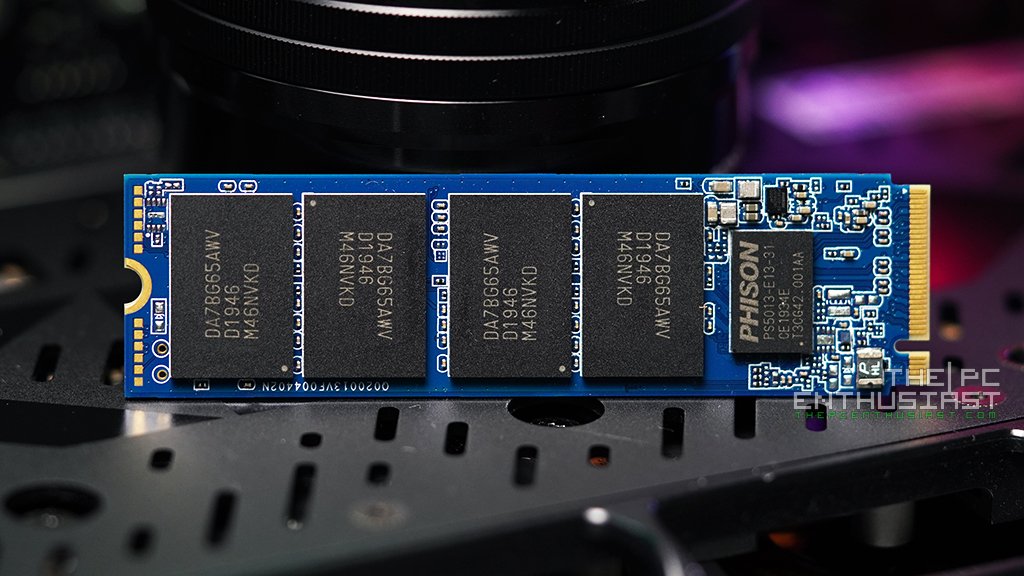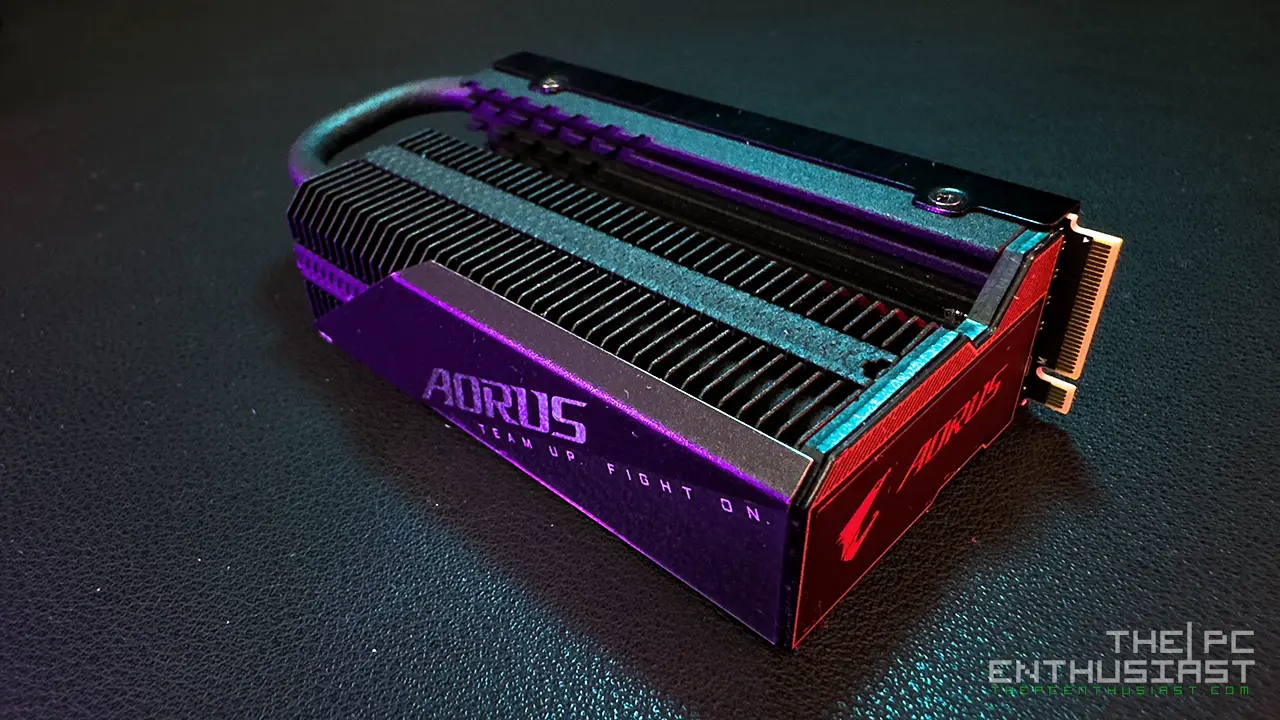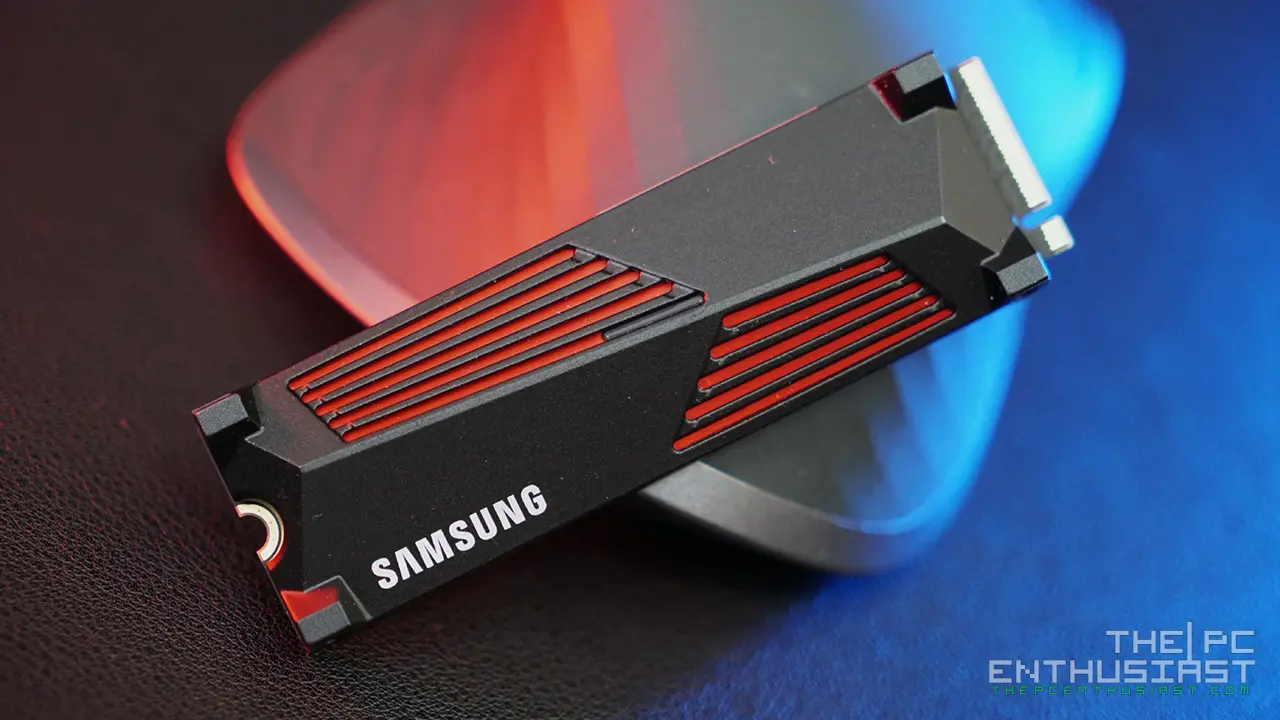Today we are going to check out and review the Patriot P300 M.2 PCIe Gen3 x4 1TB SSD (US version). It uses a Phison PS5013 controller and 96 Layer TLC NAND from Kioxia, but features a DRAM-less design. This is the company’s entry-level NVMe SSD, quite the opposite of the Patriot Viper VP4100, which is a PCIe Gen4 SSD and the fastest that the company has to offer. Let’s check out how the Patriot P300 performs and if it’s worth to buy one despite being DRAM-less. Continue reading our Patriot P300 M.2 PCIe SSD 1TB review below.
Patriot P300 M.2 PCIe Gen3 SSD Review – 1TB Capacity US Version
There are two versions of the Patriot P300 SSD series; the blue one which is the US version and a black one which is a non-US version. I’m not sure why there are two versions; and unfortunately, we don’t get the more aesthetically pleasing black PCB here in the US.
A Phison PS5013-E13T chip controls the Patriot P300 NVMe SSD. It is basically a DRAM-less controller with 4 channels and 4 lanes. Despite having no DRAM, it does make use of HMB or Host Memory Buffer technology in Windows 10. It’s a low-level shared memory interface that allows the P300 to use some of the Windows 10’s system memory as its caching space.
The Patriot P300 NVMe SSD also features end to end data path protection and SmartECC technology to ensure data integrity. These features are accompanied by advanced wear-leveling and thermal throttling technology that extends the life of the drive.
The Patriot P300 comes in a simple packaging, with a “High Performance” indicator at the bottom. However, the performance indicator doesn’t tell you the whole story, and at the back you can read some of its features. The print at the back only mentions that it has a read speed of up to 2,100 MB/s; that’s true only for the 1TB capacity. And they didn’t mention the write speed, which is only (up to) 1,650MB/s for the 1TB capacity.
Speaking of capacity, the P300 series is available from 128GB up to 2TB capacity. However, I can’t find a 128GB and 2TB available in the market as of writing this review. That’s why I only added the 256GB, 512GB and 1TB on the specs sheet below.
This drive has a standard M.2 2280 form factor, so it should be compatible with most motherboards, or laptops, in the market supporting M.2 PCIe Gen3 x4 interface. The Patriot P300 1TB capacity only has its one side populated. There is nothing on the back side of the PCB. Above you can see four BiCS4 96L NAND chips from Kioxia that totals 1TB and the Phison PS5013-E13T controller chip near the M.2 interface.
By the way, the brand Kioxia may be unfamiliar to you, but Kioxia is actually Toshiba, well formerly. They changed their company name end of 2019 last year. So, don’t fret regarding the quality of the NAND flash. Toshiba’s NAND flash are commonly used in many SSDs in the market and they are known for their quality and performance. Nothing has change, except for the brand name.
Patriot P300 PCIe Gen3 SSD Specifications
| 256GB | 512GB | 1TB | |
|---|---|---|---|
| Model | P300P256GM28US | P300P512GM28US | P300P1TBM28US |
| Form Factor | M.2 2280 | M.2 2280 | M.2 2280 |
| Interface | PCIe 3.0 x4, NVMe 1.3 | PCIe 3.0 x4, NVMe 1.3 | PCIe 3.0 x4, NVMe 1.3 |
| Controller | Phison PS5013-E13 | Phison PS5013-E13 | Phison PS5013-E13 |
| NAND Flash | 96L TLC Kioxia | 96L TLC Kioxia | 96L TLC Kioxia |
| Sequential Read | 1700 MB/s | 1700 MB/s | 2100 MB/s |
| Sequential Write | 1100 MB/s | 1100 MB/s | 1650 MB/s |
| Random Read | 290,000 IOPS | 290,000 IOPS | 290,000 IOPS |
| Random Write | 260,000 IOPS | 260,000 IOPS | 260,000 IOPS |
| Power Consumption | Idle: 0.37W Full: 2.07W | Idle: 0.37W Full: 2.07W | Idle: 0.38W Full: 2.38W |
| Endurance (TBW) | 80TB | 160TB | 320TB |
| MTBF | 2M hours | 2M hours | 2M hours |
| DWPD | 0.28 | 0.28 | 0.28 |
| Warranty | 3 years | 3 years | 3 years |
Patriot P300 Review – Test Setup
In testing the Patriot P300 M.2 NVMe SSD 1TB capacity, I am using an MSI MEG Z390 ACE motherboard powered with an Intel Core i7-8700K CPU. Below are the rest of the system’s specifications:
Operating System: Windows 10 Pro 64bit
Motherboard: MSI MEG Z390 ACE
Processor: Intel Core i7-8700K
CPU Cooler: Corsair H100i RGB Platinum
Memory: ADATA Spectrix D60G
Graphics card: XFX Radeon RX 5600 XT Thicc II Pro
Storage Drives: Samsung 970 EVO Plus 500GB (OS)
Power Supply: Seasonic 1050W Platinum
Chassis: Thermaltake Core P3
In this review, I’m going to add several drivers for comparison; from a hard disk drive all to way to a high performance NVMe Gen3 SSD. Do note though that I don’t have any other DRAM-less NVMe to compare directly with the Patriot P300. The Crucial P1 is the closest to the P300 that I’ve got. It’s also an entry-level M.2 NVMe SSD, but it’s not DRAM-less. I also listed the sequential read and sequential write speeds of the following drives below for reference.
| Drive | Sequential Read | Sequential Write |
|---|---|---|
| WD Red PRO 10TB HDD | 260MB/s | 260MB/s |
| Kingston KC600 1TB SSD | 550MB/s | 520MB/s |
| Samsung 860 PRO 1TB SSD | 560 MB/s | 530 MB/s |
| Crucial P1 1TB NVMe | 2,000 MB/s | 1,700 MB/s |
| ADATA Spectrix S40G 1TB | 3,500MB/s | 3,000MB/s |
| WD Black SN750 1TB | 3,430MB/s | 3,000MB/s |
| Seagate FireCuda 510 1TB | 3,450MB/s | 3,200MB/s |
Now time to see the results…
Patriot P300 Real World Copy Test
For the real-world copy test, I copied 3DMark’s installer that has a size of ~6GB zip file. The screenshot above shows the file copied from the Samsung 970 EVO Plus to the Patriot P300. The 6GB file was successfully copied under a few seconds only, with a transfer speed of around 1.60+ GB/s.
I wanted to see if the transfer speed would be affected if I copy a much larger file size. The above screenshot shows an ~18GB zip file copied from the Samsung 970 EVO Plus to the Patriot P300. The copy process took a few seconds more; also notice that there’s a dip in the performance by about half of the speed of the initial burst.
I’m guessing that without the HMB feature, the transfer speed could be slower. It’s a good thing that the P300 has this feature.
Now let’s see some synthetic benchmarks…
AJA Benchmark Results
In AJA System test, we can see that the Patriot P300 performs slightly slower than the Crucial P1 when it comes to write speed, but it outperforms the P1 when it comes to read speed. The P300 was able to hit its advertised read speed in this test.
AS SSD Benchmark Results
The same result can be observed in AS SSD benchmark, where the P300 is a bit slower when it comes to write speed, but actually excels in read speed. Unsurprisingly, the ADATA Spectrix S40G falls behind in the sequential write test.
Surprisingly, the Samsung 860 PRO 1TB SATA SSD, performed better in the 4K random test in this round.
ATTO Disk Benchmark Results
ATTO disk benchmark usually reflects the advertised speed of a storage drive. But it doesn’t necessarily reflect the drive’s real-world capabilities. Here we can see that the Patriot P300 1TB capacity was able to reach both its sequential read and sequential write speeds. We can also see that it slightly edges the Crucial P1.
CrystalDiskMark Benchmark Results
Interestingly, the Patriot P300 outperformed the Crucial P1 in the sequential test of CrystalDiskMark, both in write and read speeds. However, the story is quite the opposite when it comes to the 4K random test. But at 4K random the Patriot P300 slightly outperformed the Spectrix S40G in 4K random write and it’s almost on par with the WD Black SN750.
ezIOmeter Benchmark Results
In ezIOmeter, the Patriot P300 1TB capacity was able to beat the Crucial P1 in sequential write test, but it got outperformed in the 4KB random test. Also notice that in this test, we can see the higher-tier M.2 NVMe SSDs outperforming the other NVMe drives by a significant margin. The WD Black SN750 and FireCuda 510 have a faster read and write speeds, not to mention they’re also a bit expensive compared to the Patriot P300.
Now, let’s test the drive with a more comprehensive benchmark suite.
PCMark 8 Storage Benchmark Results
The PCMark 8 storage benchmark tests the performance of SSDs, HDDs and hybrid drives with traces recorded from Adobe Creative Suite, Microsoft Office and a selection of popular games. It also highlights real-world performance differences between storage devices unlike synthetic storage tests.
Just like in most of the tests above, we can see that the Patriot P300 performs faster than the fastest SATA SSD, but it’s a bit slower compared to other higher tier NVMe SSDs. The performance of the P300 isn’t actually bad overall, considering that it’s almost on par with the Spectrix S40G that has a much faster sequential read and write speed.
PCMark 10 Full System Drive Benchmark Results
Last but definitely not the least test is the PCMark 10 full system drive benchmark. This test uses a wide-ranging set of real-world traces from popular applications and common tasks to fully test the performance of the fastest modern drives, including PCIe 4.0 NVMe storage devices and new technologies like Intel’s Optane. This will give us a more realistic expectation of a drive’s performance and a closer to real-world testing scenario.
This test took about 1 hour to finish, shorter and faster than the PCMark 8 storage test. But it uses newer methods to test a drive. In this test we can see that the Patriot P300’s performance is within specs. It’s an entry level M.2 so I expect it to be faster than a SATA SSD, but not as fast compared to higher-tier M.2 NVMe PCIe Gen3 SSDs.
Patriot P300 M.2 NVMe 1TB SSD Review Conclusion
Overall, the Patriot P300 M.2 NVMe SSD 1TB capacity that I got here performed as expected. It has a rated speed of 2,100MB/s sequential read and 1,650MB/s sequential write. I’m not expecting that it would outperform the higher-end NVMe SSDs, but at least it was able to achieve its advertised speed.
One thing that is a head scratcher for me is, why is there a US version with Blue PCB and a non-US version with a Black PCB? Definitely, the one with a black PCB looks much better aesthetically speaking. And I’m positive that many would prefer a black PCB on their SSD drive. However, that will no longer matter if you are planning to install this in a laptop or behind a heatsink anyway.
Patriot Memory is also offering a 3-year warranty which I think is reasonable for its price, aside from the 320TB of Total Bytes Written rating of the 1TB drive. The only obstacle for the P300 that I can think of is the plethora of competition. There are a lot of M.2 NVMe SSDs in the market and competition is fierce. Patriot Memory has to keep their pricing for the P300 series low enough to remain competitive and more attractive compared to other (entry-level) M.2 NVMe drives.
Finally, the Patriot P300 1TB capacity is not the fastest M.2 NVMe SSD around, but it is definitely NOT bad as well. Its performance is good enough for normal desktop operation or for those who are seeking a faster and smoother experience than a hard disk drive or SATA SSD without breaking the bank. If you want to save some cash, the P300 is a good option. Just be sure that you get it at a lower price compared to the other 1TB M.2 NVMe drives.

























